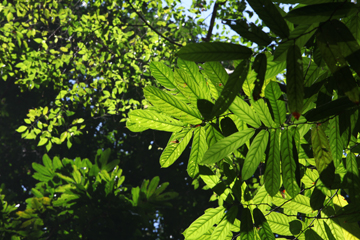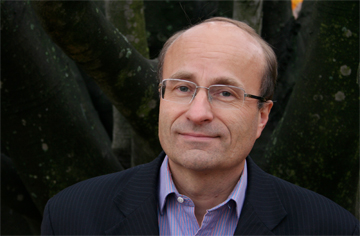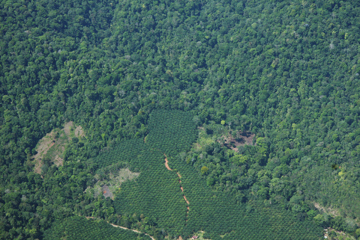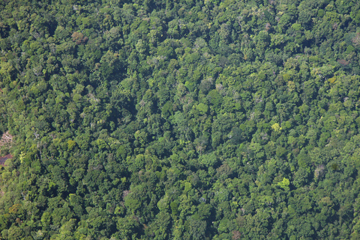Scandinavian country with population 1.5 percent that of the United States is the biggest international funder of rainforest conservation.
While citizens in western countries have long paid lip service to saving rainforests, Norway has quietly emerged as the largest and most important international force in tropical forest conservation. The small Scandinavian country has committed 3 billion krone ($440 million) a year to the effort, a figure vastly greater than the $100M pledged — but never fully contributed — by the United States under the Tropical Forest Conservation Act (TFCA). Norway now hopes it can help push to include forest conservation in the successor to the Kyoto Protocol by providing funding and fostering cooperation among international actors like the UN and World Bank, as well as developing countries, to fund the creation of an international architecture which makes it possible to incorporate deforestation and degradation into a post-2012 climate regime.
 Rainforest in Costa Rica |
Norway’s leadership on forest conservation arose from its concern over the impacts of climate change and what it sees as an attractive source for cuts in carbon dioxide emissions: reducing deforestation and forest degradation, which together account for roughly 20 percent of emissions caused by human activity or more than all the world’s trucks, cars, ships and airplanes combined. The country, which is the world’s third-largest gas exporter, the fourth-biggest oil exporter, and has some of the highest emissions per capita in Europe, aims to be carbon neutral — in terms of compensating for all remaining domestic emissions through emission reductions in other countries — by 2030. Although Norway was among the first countries in the world to adopt a carbon tax (in 1991) and hydropower is the source of nearly 99 percent of its electricity, it needs to aggressively reduce n emissions to meet its targets.
Norway’s intention to support forest conservation as a mechanism for reducing greenhouse gas emissions was announced by Prime Minister Jens Stoltenberg at the 2007 United Nations Framework Convention on Climate Change (UNFCCC) in Bali, Indonesia. At the time, Reducing Emissions from Deforestation and Degradation (REDD), was still a somewhat esoteric idea for curtailing emissions; one championed by a handful of major conservation groups, a coalition of tropical nations led by Papua New Guinea, and the World Bank. Today the landscape has changed. REDD — in various forms — is backed by a broad range of interests, from politicians to business leaders to environmental groups. Still, few have ventured forth with the funds needed to jumpstart REDD projects. The United States for example has not directly committed money to the initiative. Norway hopes its commitment will prod other countries to follow its example.
 Hans Brattskar |
“The Norwegian government realized REDD was a field which needed leadership in order to kick start the process,” Hans Brattskar, ambassador and director of the Norwegian government’s International Climate and Forest Initiative, told mongabay.com. “Norway, by making significant initial contributions, could be catalytic in the sense that we could start building the international framework needed to make it easier for other countries to follow.”
“Our main goals are to include emissions from deforestation and degradation in a new climate regime and to reduce emissions from forests—but we also recognize that this may have added value in terms of protecting biodiversity, strengthening indigenous people’s interests and improving local livelihoods,” he continued.
The Norwegian government cites these multiple benefits — a “triple dividend” — as the critical reason for supporting REDD. It also sees REDD as an opportunity to engage developing countries in climate negotiations set to resume in Copenhagen this December.
“We think it is important to underline that REDD is more than development aid, and more than combating climate change,” Brattskar said. “It might seem ambitious but we strongly hope that the work with reduced emissions from deforestation and forest degradation can create deep, substantial, lasting partnerships between developed and developing countries to help put the latter on the path to genuine, sustainable, low-carbon development.”
 Oil palm plantation border rainforest. Oil palm has arisen as an important driver of deforestation in Southeast Asia |
Norway is optimistic about the potential of REDD to simultaneously reduce the risk of dangerous climate change, alleviate rural poverty, and protect ecosystem services and biodiversity. But it notes that daunting challenges need to be overcome, including building capacity for developing nations to reduce deforestation, thus ensuring equitable distribution of benefits to stakeholders including forest people, verifying reductions in emissions, and providing the long-term funding needed to compete economically with the primary drivers of deforestation, among them agriculture and logging.
“REDD is recognized as a cost-effective and relatively fast way to reduce emissions,” Brattskar said, but added that it will be neither cheap nor easy. “Our main goal and challenge is the inclusion of REDD in a future climate regime, in a form that ensures cooperation and predictable financing for REDD in developing forest countries.”
Norway has demonstrated its willingness to commit substantial sums for forest conservation — provided recipient countries honor their commitments to reduce deforestation. Last year Norway pledged up to a billion dollars to Brazil’s Amazon Fund, an initiative that seeks to reduce deforestation in the Brazilian Amazon by 70 percent relative to a 1996-2005 baseline. It also announced NOK 500 million ($73 million) towards the development and implementation of a national REDD strategy in Tanzania over the next five years, millions of dollars for the South American country of Guyana, and more than $100 million to Congo Basin countries. It continues to seek new partnerships and opportunities in countries committed to developing national strategy plans for REDD. Most of the support is channeled through multilateral organizations such as the African development bank (which administers the Congo Basin Forest Fund), the World Bank (Forest Carbon Partnership Facility) and the UN (UN Redd Programme) that support countries in drafting national strategies for REDD.
Norway is counting on other industrialized nations to eventually join the effort initiative by supporting multilateral processes for REDD. Brattskar said Britain is already providing financial backing for the Congo Basin Forest Fund while Germany is supporting forest conservation through its international climate initiative. He said other donor countries are showing “great interest”.
“In addition to our contributions to the World Bank’s Forest Carbon Partnership Facility (FCPF), which is also supported by a number of other countries, Norway is financing the first phase of the United Nations’ REDD program,” which is run by three UN agencies, UNEP, FAO and UNDP. “In the long run, this needs to be supplemented by funding from other donors. We do not want this to be seen as a ‘Norwegian project’.”
“We are certainly not alone in this field. At the same time, we would strongly appreciate more countries’ getting involved and providing support to REDD efforts.”
 Norway’s recent commitments
|
Norway has demonstrated its willingness to commit substantial sums for forest conservation — provided recipient countries honor their commitments to reduce deforestation. Last year Norway pledged up to a billion dollars to Brazil’s Amazon Fund, an initiative that seeks to reduce deforestation in the Brazilian Amazon by 70 percent relative to a 1996-2005 baseline. It also announced NOK 500 million ($73 million) towards the development and implementation of a national REDD strategy in Tanzania over the next five years, millions of dollars for the South American country of Guyana, and more than $100 million to Congo Basin countries. It continues to seek new partnerships and opportunities in countries committed to developing national strategy plans for REDD. Most of the support is channeled through multilateral organizations such as the African development bank (which administers the Congo Basin Forest Fund), the World Bank (Forest Carbon Partnership Facility) and the UN (UN Redd Programme) that support countries in drafting national strategies for REDD.
Norway is counting on other industrialized nations to eventually join the effort initiative by supporting multilateral processes for REDD. Brattskar said Britain is already providing financial backing for the Congo Basin Forest Fund while Germany is supporting forest conservation through its international climate initiative. He said other donor countries are showing “great interest”.
“In addition to our contributions to the World Bank’s Forest Carbon Partnership Facility (FCPF), which is also supported by a number of other countries, Norway is financing the first phase of the United Nations’ REDD program,” which is run by three UN agencies, UNEP, FAO and UNDP. “In the long run, this needs to be supplemented by funding from other donors. We do not want this to be seen as a ‘Norwegian project’.”
“We are certainly not alone in this field. At the same time, we would strongly appreciate more countries’ getting involved and providing support to REDD efforts.”
Full text of the interview with Hans Brattskar
-
mongabay: What led Norway to identify forests as a means to reduce greenhouse gas emissions?
Brattskar: The main reason for why the government of Norway initiated our work with REDD is of course that emissions from deforestation and forest degradation measure up to almost one-fifth of total greenhouse gas emissions. The Norwegian government realized REDD was a field which needed leadership in order to kick start the process, and where Norway, by making significant initial contributions, could be catalytic in the sense that we could start building the international framework needed to make it easier for other countries to follow.
Norway is a forest-nation and several Norwegian NGOs are involved in work with tropical forest countries, therefore it was natural that this became a focused topic in the country. Our main goals are to include emissions from deforestation and degradation in a new climate regime and to reduce emissions from forests—but we also recognize that this may have added value in terms of protecting biodiversity, strengthening indigenous people’s interests and improving local livelihoods.
mongabay: What are Norway’s principle concerns with REDD in terms of the challenges that need be overcome to make it a reality?
Brattskar: There are of course several challenges. The drivers behind deforestation are strong and to find ways within each country to reduce the deforestation is probably the main challenge. Another challenge is to establish funding mechanisms for REDD to that generate sufficient funds to make REDD possible at a scale that really matters to combat climate change and to provide the developing countries with long-term, predictable compensation for their REDD-achievements. REDD is recognized as a cost effective and relatively fast way to reduce emissions, but as we like to say: that does not mean it is neither cheap nor easy. Our main goal and challenge is the inclusion of REDD in a future climate regime, in a form that ensures cooperation and predictable financing for REDD in developing forest countries.
REDD financing should in the future be based on results based compensation – that is, developed countries should provide compensation to tropical forest countries based on reduced or limited emissions. I believe key words here are coordination and verification. The REDD efforts need to be coordinated, and the results must be verifiable. One challenge is to build systems for measuring, reporting and verifying (MRV) emission reductions. We are convinced that it is now technically possible to monitor deforestation and forest degradation with satisfying precision. But it will take a lot of investments and capacity building to establish national MRV-systems in many developing countries.
It is also important to ensure a coordination of REDD efforts. We believe the multilateral institutions, like the UN, the World Bank and the African Development Bank should play important roles in this coordination. The efforts must be anchored at a national level, based on inclusive, holistic, multi-stakeholder national strategy building and implementation processes – and the national governments must cooperate with an international organization such as the UN, the World Bank or the African Development Bank.
It is important that REDD efforts are not fragmented, and we feel that we are doing great progress in this field. The World Bank and the UN are for example working together in an extraordinarily well coordinated way on REDD.
Our main goal and challenge is of course to include REDD in a future climate regime – in order to ensure cooperation and predictable financing for REDD in tropical forest countries.
mongabay: Is Norway is finding support for REDD from other industrialized governments?
Brattskar: In addition to our contributions to the World Bank’s Forest Carbon Partnership Facility (FCPF), which is also supported by a number of other countries, Norway is financing the first phase of the United Nations’ REDD program which is run by the UN agencies of UNEP, FAO and UNDP. In the long run, this needs to be supplemented by funding from other donors. We do not want this to be seen as a ‘Norwegian project’. One main reason for establishing the multilateral UN REDD program is for other countries to be able to easily fund REDD. It is also important that REDD is included in the climate regime after 2012. We will not be able to reduce emissions from deforestation and forest degradation through fragmented approaches.
So far, Britain is funding the Congo Basin Forest Fund together with Norway, and Germany providing significant support inter alia to forest conservation through its international climate initiative. Other donor countries also show great interest in REDD.
We think it is important to underline that REDD is more than development aid, and more than combating climate change. It might seem ambitious but we strongly hope that the work with reduced emissions from deforestation and forest degradation can create deep, substantial, lasting partnerships between developed and developing countries to help put the latter on the path to genuine, sustainable, low-carbon development.
Related articles
Norway to pay Guyana to save its rainforests
(02/05/2009)
Norway will provide financial support for Guyana’s ambitious plan to conserve its rainforests, reports the Guyana Chronicle. Meeting in Oslo, Norway on Tuesday, Guyana President Bharrat Jagdeo and Norwegian Prime Minister Jens Stoltenberg signed a Memorandum of Understanding agreeing to establish a partnership to reduce greenhouse gas emissions from deforestation and forest degradation (REDD). The leaders will push for the incorporation of a REDD mechanism that includes low deforestation countries like Guyana in a post-2012 climate change agreement.
Norway offers $1 billion towards saving the Amazon rainforest
(09/17/2008)
Norway will donate up to a billion dollars to a Brazilian government fund that aims to protect the Amazon rainforest.
Britain, Norway commit $210 million towards Congo rainforest conservation
(06/24/2008)
The governments of Britain and Norway last week announced a $211 million (£108 million) initiative to conserve rainforests in the Congo Basin. The plan calls for the use of an advanced satellite camera to monitor deforestation in the region and funding for community-based conservation projects.
Norway puts $560m toward rainforest conservation
(12/09/2007)
Norway will commit NOK 3 billion ($560m) to rainforest conservation efforts in an effort to slow climate change, reports Aftenposten, a Norwegian newspaper.